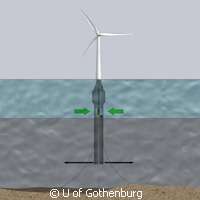Oxygenation and life in the Baltic Sea

Can you bring something back from the dead? Scientists in Sweden say that if it's at the bottom of the sea and oxygenation is present, you can. Oxygenation gives ecosystems the boost they need to come to life and helps nature deal with eutrophication, the bloom of phytoplankton in water.
University of Gothenburg researchers carried out pilot studies in two Swedish fjords and determined that pumping oxygen-rich surface water down to the bottom of the sea gave them the results they were searching for. The team is now gearing up to test a large wind-driven pump in open water in the Baltic Sea.
'Today everyone is focused on reducing nutrient inputs to the sea in order to reduce eutrophication in the Baltic, but by helping nature itself to deal with the phosphorus that is discharged we can create a turbo effect in the battle against eutrophication,' explained Anders Stigebrandt, Professor Emeritus at the Department of Earth Sciences at the University of Gothenburg.
Oxygenating dead sea bottoms is not a novel idea. Researchers suggest that the idea of oxygenating dead sea bottoms comes from nature itself. For instance, oxygenating the deep water in the Baltic Sea is like creating wetlands on land, they say. In order for both of these methods to succeed, conditions must be created to give ecosystems what they need. And this is made possible by setting up new ecosystems that can bind the nutrients successfully.
"If oxygen-free bottoms in the Baltic are oxygenated, it can be anticipated that every square kilometre of bottom surface will be able to find 3 tonnes of phosphorus in a short time, which is a purely geochemical effect," Professor Stigebrandt said. "If the bottoms are then kept oxygenated for a prolonged period, fauna becomes established on and in the bottoms. This leads to the bottom sediments being oxygenated down to a depth of several centimetres, and the new ecosystem probably contributes to the possibility of further phosphorus being bound to the sediment."
The Baltic Deepwater Oxygenation (BOX) project, led by Professor Stigebrandt, is testing the theory that prolonged oxygenation of the Baltic deep water triggers extended and intensified binding of phosphorus in bottom sediment. What researchers want to know is how the oxygenated deep-water areas can bind phosphorus in the longer term. So they have launched pilot studies in Kanholmsfjärden on the east coast and in Byfjorden in the west coast, and conducted laboratory experiments. BOX is tackling the colonisation of oxygenated bottoms and its impact on phosphorus uptake.
For the open water test, the team will use a pump that can pump 30 cubic metres of water per second. Contained in a 60-metre high and 100-metre deep tubular buoy anchored in an open location, the pump is not affected by wave motions.
"The pump is to have [the] capacity to pump 30 cubic metres of water per second, which is 15 times more than the pump in the Byfjord experiment," Professor Stigebrandt said. "If this works, using a five times larger pump in a buoy around 120 metres deep should not pose major problems. This is the size we anticipate pumps needing to have in a future large-scale system for oxygenation of the Baltic deep water."
More information: www.marsys.se/lang/se/about-us … ter-oxygenation-box/
Provided by CORDIS


















